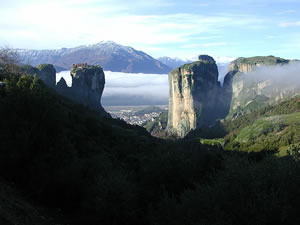Metéora, on the western edge of the plain of Thessaly, in the heart of northern Greece, is the home a group of monasteries and chapels that are perched on 24 enormous rocks.
The rocks are made of a mixture of sandstone and a type of hard, sedimentary gravel known as conglomerate.
Around 60 million years ago, these rocks were part of a seabed that covered what is now the plain of Thessaly. Later, a series of seismic movements in the region thrust the seabed upward to form a high plateau and split the thick layer of sandstone into innumerable faults. Weathering by wind, water and extremes of temperature wore away the fractured sandstone, leaving behind pillars that have been called "the rocky forest of Greece".
 Hermits and religious ascetics first inhabited the rocky pinnacles, some of which reach 550m (1,800ft) tall, during the 9th century. The hollows and fissures in the rocks offered the anchorites shelter from the elements, while the sheer cliff walls deterred casual visitors from interrupting their constant soul-searching and prayers.
Hermits and religious ascetics first inhabited the rocky pinnacles, some of which reach 550m (1,800ft) tall, during the 9th century. The hollows and fissures in the rocks offered the anchorites shelter from the elements, while the sheer cliff walls deterred casual visitors from interrupting their constant soul-searching and prayers.
On Sundays and special feast days the hermits gathered together for worship and prayer in a chapel at the foot of the round-topped rock known as Doupiani. By the end of the 12th century, they had organized themselves into a loose-knit community.
The Great Meteoron
By the 14th century, the Byzantine Empire, which had ruled the region for more than eight centuries, was beginning to lose its grip. The rich and fertile plain of Thessaly became a battleground as Serbian kings and Turkish raiders vied with each other, and the Byzantine Empire, for supremacy of northern Greece. Peaceful monastic communities seemed particularly vulnerable to the conflicts.
In 1334, the monastery of Mount Athos to the southeast of Thessalonica was abandoned. Ten years later, the monk Athanasios led a group of fugitives to Metéora. Between 1356 and 1372, on a pinnacle known as Broad Rock, Athanasios founded the Great Meteoron monastery.
Broad Rock was ideally suited to the reclusive needs of Athanasios and his followers. Once established on the precipitous rock they had complete control of access. A long ladder provided the only route to the top and this could be drawn up by the monks whenever they felt threatened. As the original, simple dwellings became inadequate to house the increasing number of monks seeking refuge in Metéora, larger and more impressive buildings were begun. The ladder was replaced by a net and rope device operated via a windlass from an overhanging gantry.
Later, this precarious method of entry was replaced by a flight of 115 steps hewn out of the rock.
The Monastery of Varlaam
The monastery of Varlaam is perched on an obelisk adjacent to the Great Meteoron. It was built by the brothers Theophanes and Nectarios in 1517. The Church of All Saints is adorned with frescoes painted in 1548 by hagiographer Franco Catellano that depict scenes from the lives of Jesus Christ and the Virgin Mary.